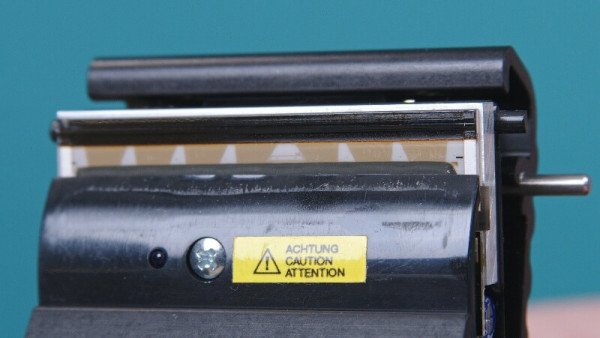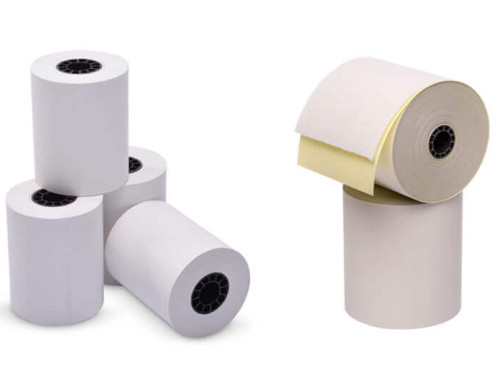There are many different types of print paper available for various applications. Two common types of print paper are thermal paper and normal paper, they are used in different print processes and have different properties. In this article, we will walk you through the differences between thermal paper and normal paper.
Let us start with the basics.
What’s Thermal Paper and How Does It Work?

Thermal paper Source: Panda Paper Roll
Thermal paper is a specialized type of paper that is coated with a chemical that reacts to heat. The chemical, which is invisible, is usually made up of dyes and developers, reacts at high temperatures and turns black when exposed to heat.

A thermal print head Source: wikipedia.org

A closer look at thermal print heads Source: Panda Paper Roll
The heat is typically applied by the print head in a thermal printer, which heats up and applies pressure to the paper, causing the chemical to react and create an image or text – this process is called direct thermal printing.
Thermal paper is commonly used in point-of-sale (POS) systems, such as cash registers and credit card terminals, as well as in fax machines, thermal label printers, and other types of thermal printers.
What’s “Normal Paper” and How Does It Work?
Normal paper, also known as inkjet paper or bond paper, is a type of paper that is not coated with any special chemicals. It is typically made from wood pulp or other plant fibers and is used for a wide variety of applications, such as writing, printing, and drawing. The most used normal paper is A4 paper, we use it every day in the home and office.
Normal paper works by absorbing ink or toner onto its surface rather than reacting to heat like thermal paper. This means that normal paper requires a printing process involving ink or toner, such as inkjet or laser printing.
The Difference Between Them
The main difference between thermal paper and normal paper is the way they are printed. Thermal paper is printed using a thermal printer, which applies heat and pressure to create an image or text, while normal paper is printed using an inkjet or laser printer, which applies ink or toner to the paper’s surface.
Another key difference is that thermal paper, as introduced above, is usually coated with a chemical that reacts to heat, which makes it sensitive to light and heat. This means thermal paper can fade or darken over time if it is exposed to sunlight and heat, while normal paper is not as sensitive and can last longer.
In terms of durability, thermal paper is often less durable than normal paper, as it can easily be scratched or torn, and the printed image or text can be easily rubbed off. Normal paper, on the other hand, is more durable and can withstand more wear and tear.
Can You Use Thermal Paper in a Normal Printer?
The short answer is NO. You cannot use thermal paper in a normal printer because thermal paper requires heat to create an image, while normal printers use ink or toner to print on paper.
Trying to use thermal paper in a normal printer can damage the printer and create a fire hazard, as the heat generated by the printer could cause the thermal paper to ignite. Additionally, the chemical coating on thermal paper can cause damage to the print heads in normal printers, which are not designed to handle the reactive chemicals found in thermal paper.
Therefore, using the correct type of paper for your printer or POS system is essential. Using the wrong type of paper can damage your equipment and result in poor quality prints that are difficult to read and may not last long.
Tips to Choose the Right Thermal Paper

The popular thermal roll size 80mm x 80mm Source: Panda Paper Roll
1. Ensure the Right Size
Thermal paper rolls are not presented in a uniform size. Instead, the thermal paper market offers several paper roll sizes that are appropriate for various application fields. Thus, it would help if you considered several factors rather than randomly selecting the thermal paper roll. Make sure the printer’s width matches the thermal printing roll by first determining it. Remember that longer thermal papers are more cost-effective because they can print more receipts as you take the length into account as well.
2. Paper Quality
Not all thermal paper is created equal, so be sure to choose a high-quality paper that is durable and resistant to fading. Using high-quality thermal paper helps prevent spotted printing. Tear a sample of the thermal paper, then heat the back with a lighter to check its quality. A high-quality thermal paper should turn black with a hint of green after heating, and the color block should look consistent.
Some thermal paper rolls are coated with a protective layer that helps to prevent fading and ensure that the printed image or text remains legible over time. Consider choosing a roll with a protective coating if you plan to use
3. Pricing
While it may be tempting to opt for the cheapest option, it is important to keep the balance between price and quality to ensure that you are getting a product that meets your needs and provides value for money.
Conclusion
Thermal paper differs from normal paper in several ways. There are some benefits of using thermal paper over normal paper. Moreover, when you buy thermal paper rolls, be sure to consider the size, quality, and price to ensure that you are getting what you are paying for. If you are looking for high-quality thermal paper rolls at competitive prices, look no further than Panda Paper Roll. Panda Paper Roll can offer a wide selection of thermal paper rolls compatible with a range of printers and POS systems. We offer worldwide shipping and excellent customer service. Contact us today to learn more about our products and services.







What is the length of 80*80mm